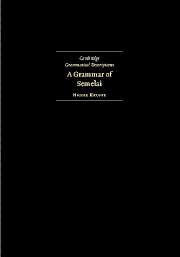Book contents
- Frontmatter
- Dedication
- Contents
- Tables and figures
- Preface
- Acknowledgements
- Abbreviations and conventions
- Maps
- 1 Semelai
- 2 Phonology and phonotactics
- 3 Morphology
- 4 Word classes
- 5 The verb
- 6 Pronouns: personal, ignorative, and demonstrative
- 7 The noun phrase
- 8 Prepositions and the prepositional phrase
- 9 Grammatical relations, constituent order and coding strategies
- 10 Basic clauses
- 11 Complex clauses
- 12 Expressives
- 13 The quotative marker, interjections and discourse clitics
- 14 Texts
- Vocabulary
- References
- Index
6 - Pronouns: personal, ignorative, and demonstrative
Published online by Cambridge University Press: 05 November 2014
- Frontmatter
- Dedication
- Contents
- Tables and figures
- Preface
- Acknowledgements
- Abbreviations and conventions
- Maps
- 1 Semelai
- 2 Phonology and phonotactics
- 3 Morphology
- 4 Word classes
- 5 The verb
- 6 Pronouns: personal, ignorative, and demonstrative
- 7 The noun phrase
- 8 Prepositions and the prepositional phrase
- 9 Grammatical relations, constituent order and coding strategies
- 10 Basic clauses
- 11 Complex clauses
- 12 Expressives
- 13 The quotative marker, interjections and discourse clitics
- 14 Texts
- Vocabulary
- References
- Index
Summary
In §6 three types of pronouns are discussed. In §6.1 the discussion begins with personal pronouns. Ignorative pronouns are introduced in §6.2. The term ignorative is adopted following Wierzbicka (1980) for the multifunctional class of wh- words and indefinite, negative and free-choice pronouns. The chapter closes with a section on demonstratives in §6.3. Semelai has a basic two-term proximal/distal distinction, with finer distinctions conveyed by the adnominal use of deictically specified prepositions.
6.1 Personal pronouns
Personal pronouns are used for animate entities, human and supernatural beings, ‘anthropomorphised’ animals and personified inanimates. Noun phrases understood from context do not need to be expressed: there is a high occurrence of zero representation of noun phrases (§9.4). This is particularly true for inanimate entities which cannot be expressed pronominally. Alternative strategies for encoding inanimate entities are to use a demonstrative pronoun or a nominalised locative preposition (§6.3.2).
6.1.1 Semantic distinctions in the pronominal system
Semelai has both free pronouns, and bound pronominal proclitics, both of which are set out in Table 6.1 below. The bound pronouns cross-reference the subject in the transitive clause, and while free personal pronouns are necessarily referential, this is not the case with the third person bound forms; the unidentified agent clitic ko=‘3UA’ is evidence of this.
- Type
- Chapter
- Information
- A Grammar of Semelai , pp. 170 - 201Publisher: Cambridge University PressPrint publication year: 2004

